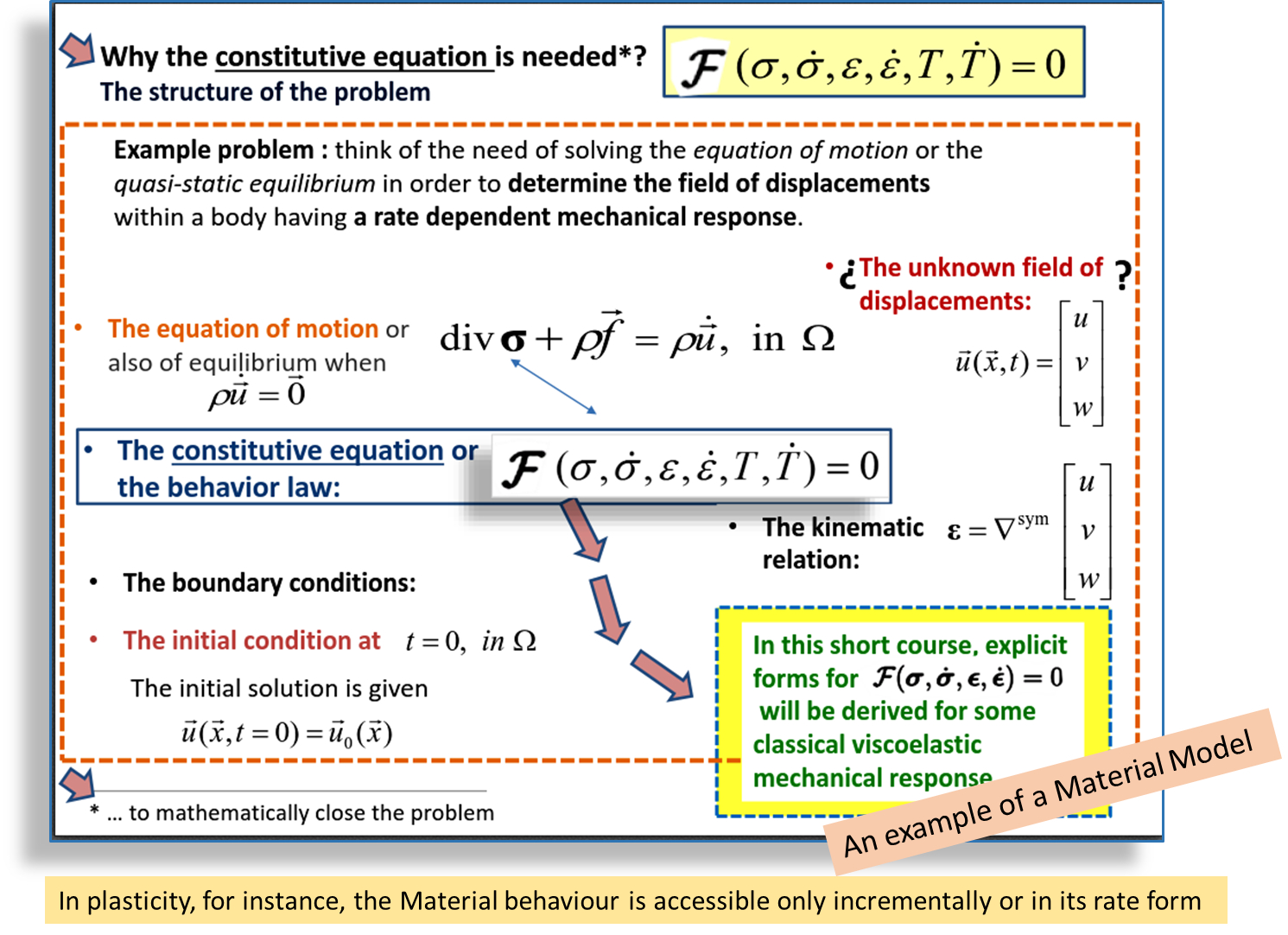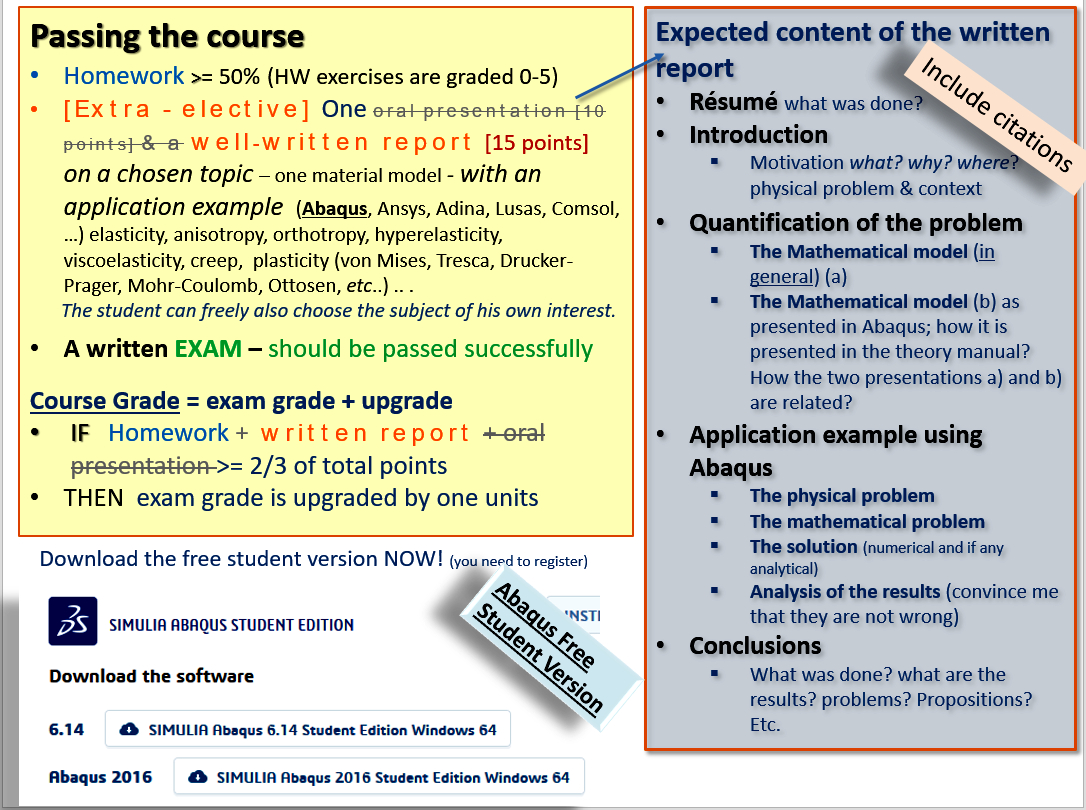CIV-E4080 - Material Modelling in Civil Engineering D, Lecture, 24.4.2023-7.6.2023
This course space end date is set to 07.06.2023 Search Courses: CIV-E4080
Topic outline
-
The course, in short
Teacher
Djebar BAROUDI, Dr.
Main goals
• Understand the fundamentals of material modelling, i.e., constitutive equations, within the framework of continuum mechanics
• Comprehend underlying physics and related mathematical descriptions of key features of common material behavior (i.e., material models) in civil engineering related to their thermo-mechanical response
• Fully understand the material models used within commonly used computational tools in civil engineering with respect to thermo-mechanical behavior of solids

Content
The course is limited to
• ELASTICITY … linear, hyper-elasticity, non-linear, isotropy, transverse isotropy, anisotropy, orthotropy
• VISCOELASTICITY
• VISCOPLASTICITY …
• PLASTICITY ... associative, non-associative
- [NEW 2020] Visco-elasticity,Viscoplasticity ... mechanics of rubbers ... X.5.2020 guest researcher from Aalto Univ. Lecturer Dr. Athanasios M.
- Damage … year 2020: damage-plasticity ex. Concrete Damage Plasticity, Models and Applications in Abaqus
Detailed content (2020):
Yearly visiting lecture by a speciallist on varying topics in material modlling:
Following visiting lectures have been given:
• 2018 [VTT Senior scientist, Dr Stefania FORTINO]: Hygro-thermo-mechanical• 2018 [VTT Scientist, Dr Alexis FEDOROFF]: Damage coupled with Plasticity for concrete
• 2019 [Adj. Professor, Dr Timo SAKSALA]: Modelling quasi-Brittle Materialsmodel for wood
[Lecturer, Dr. Athanasios Markou]: ...mechanics of rubbers and their use in CIV
Main Textbooks for the current course
(Not the whole books but chosen chapters)
• [1] Mechanics of Solid Materials . Jean Lemaitre, Université de Paris VI (Pierre et Marie Curie) & Jean-Louis Chaboche, 1994. Cambridge Univ. Press.
(Main Textbook 1, the relevant chapters and reading assignments are given during the lectures)Lemaitre & Chaboche textbook as an e-book:http://proquestcombo.safaribooksonline.com.libproxy.aalto.fi/book/physics/9781107384712• [2] Plasticity for Structural Engineers . Wai Fah Chen, D.J. Han, Springer New York, 6 Dec 2012.
(Chapters 1-5 for the engineering plasticity-part of our course … content well oriented for structural Engineers)• [3] The Mechanics of Constitutive Modeling. Niels Saabye Ottosen and Matti Ristinmaa, 2005. Elsivier.(Recommended elective textbook)* [4] Plasticity Theory. Jacob Lubliner.
(Recommended elective textbook. Some official released old versions can be found freely in the internet).
Must visit sites:https://www.appliedelementmethod.org/
<<---numerical prediction of progressive collapse of buildings due to extreme loading
http://solidmechanics.org/index.html --> summarizes physical laws, mathematical models,
and algorithms that are used to predict the response of materials and
structures to mechanical or thermal loadingThis electronic material summarizing: physical laws, mathematical models, and algorithms that are used to predict the response of materials and structures to mechanical or thermal loading.
About the course supporting Material
• In addition to the pointed chapters from the course textbooks for each topic, I will provide an additional learning/reading supporting material together with weekly homework series (3-6 exercises/week. Each exercise is marked (arvosana) 0-5 if not otherwise stated in the homework-paper).
• The Lecturer's written material is not a collection of lecture-slides but it is a learning supporting material offered to help and motivate students in their reading from the course textbooks & elsewhere.
• The topics treated in this intensive course cannot be avoided by future structural engineers: these topics will wait for them hidden, inside the FE-software you will use to perform structural analysis, in the black-boxes called material models. This course is may be the right place for first meeting them in a friendly learning environment and opening these black-boxes.
Passing the course
The individual written assignment (not to be confused with the 1st redaing assignment where the obligatory delivery is also a written report) is not compulsory. However, doing it makes you understand better and earn extra-points which may upgrade your exam grade.

15 points = 10 pnts referat + 5 pnts numerical example
- [NEW 2020] Visco-elasticity,Viscoplasticity ... mechanics of rubbers ... X.5.2020 guest researcher from Aalto Univ. Lecturer Dr. Athanasios M.
